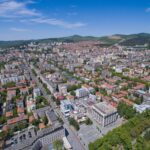The headline numbers may not be huge, but the deal is significant. This week, in a move aimed at bolstering economic ties between the UK and Uzbekistan, UK Export Finance (UKEF) announced its first major finance agreement in the Central Asian country by guaranteeing a 12.6 million euros loan.
The move represents a key step in broadening trade relations between the two countries, particularly with a focus on exports for British businesses. As both countries look to deepen their economic connections the deal not only strengthens commercial relations but also aligns with Uzbekistan’s ambitions to diversify its economy and modernise its key industries.
The UKEF guarantee allows Uzbek firms Almalyk Mining and Metallurgical Complex (AMMC), a major copper producer situated near Tashkent, to refinance its purchase of automated machinery from Scottish multinational Weir, which is expected to enhance efficiency and output.
The Weir Group, headquartered in Glasgow, creates innovative engineering solutions for minerals and mining technology markets.
This transaction is part of UKEF’s wider objective to promote the export of British machinery and technology, facilitating new avenues for trade that are beneficial to both nations.
In 2023, UK-Uzbekistan trade totaled 381 million UK pounds, with specialised machinery the fourth most-traded commodity. This underscores the growing importance of UK technology in supporting the Central Asian nation’s key sectors, particularly mining and metallurgy.
As the world pivots towards greener technologies, the demand for metals like copper—essential for electric vehicles, renewable energy, and infrastructure—has soared. AMMC is among Central Asia’s largest copper producers, and the UK’s machinery exports play a crucial role in modernising its production processes.
Given that around 90 per cent of the UK’s imports from Uzbekistan consist of non-ferrous metals, metal ores, and scrap, the partnership not only strengthens the supply chain but also boosts the UK’s presence in this critical market.
Tim Reid, CEO of UK Export Finance, highlighted the potential of the Uzbek market during a recent visit to the country.
“It is no coincidence that Uzbekistan has for centuries been at the literal crossroads of world trade. I was struck by what I saw: huge energy from a young and growing workforce, and equally huge ambitions for economic growth,” he said.
This enthusiasm is coupled with a broader goal of increasing UKEF’s role in financing development projects in Uzbekistan and throughout Central Asia. One of David Cameron’s final major visits as foreign minister before the UK’s summer general election was to the five countries of the region.
In Tashkent, in April, Cameron signed a joint declaration with his Uzbek counterpart Bakhtiyor Saidov that set out a vision of both nations to build more dynamic connections between people; increase trade and investment flows; enhance political, security and defence cooperation and engage on key issues such as climate, clean energy, sustainable socio-economic development, gender equality and decarbonisation ambitions.
Currently, UKEF has earmarked up to four billion UK pounds in financing available to support contracts in Uzbekistan, with a particular focus on initiatives that will drive sustainable social and economic development.
Expanding Uzbekistan’s trade horizons
Since 2017, Uzbekistan has been taking steps to reform its economy and open up to international trade, following years of economic isolation.
Traditionally, the country’s key trading partners have been China, Russia, Turkey, and Kazakhstan. China, in particular, remains a dominant force in the region, playing a major role in infrastructure development and trade through its Belt and Road Initiative.
Russia, meanwhile, has historically maintained strong political and economic ties, acting as both a market for Uzbek exports and a source of goods, technology, and investment.
However, recent shifts in the global economic landscape have prompted Uzbekistan to look beyond its established partners.
Efforts to diversify trade and attract foreign investment have seen the country reach out to the UK and other Western economies. The UK stands as an appealing partner due to its financial services expertise, robust regulatory environment, and growing focus on supporting clean technologies.
Given that the UK is also home to advanced machinery and technology companies like Weir, Uzbekistan’s focus on modernising its key industries aligns well with what the UK has to offer.
For Uzbekistan, increasing trade and investment ties with the UK provides several advantages.
Firstly, the can help facilitate major development projects in Uzbekistan. The UKEF-backed loan for AMMC is a prime example, offering competitive financing terms that will allow Uzbekistan to access high-quality machinery without straining its capital.
Furthermore, this financial backing from UKEF provides confidence and encourages additional investments, particularly in sectors such as mining, infrastructure, renewable energy, and construction.
Secondly, as Uzbekistan diversifies its economy, it is focusing on sectors where the UK excels.
Sustainable and clean technologies are a growing priority for Uzbekistan, particularly as the country aims to develop a greener, more efficient economy. The UK, with its experience in renewable energy, smart manufacturing, and sustainable infrastructure, can be a valuable partner. This shared interest in green and sustainable development is highlighted by UKEF’s prioritisation of projects that support clean growth.
Sevara Madgazieva, UKEF country head for Uzbekistan, emphasises this alignment of priorities.
“This is the first of many opportunities for UK Export Finance to strengthen the trading relationship between the UK and Uzbekistan. British suppliers have a lot to contribute as Uzbekistan continues to diversify its economy, which is why UKEF has billions of pounds available to support projects throughout Central Asia,” she says.
A strategic trade pivot
Uzbekistan’s interest in fostering stronger trade ties with the UK reflects a broader pivot towards engaging with diverse global markets.
This is part of the country’s reform agenda to modernise its industries, enhance its economic competitiveness, and shift towards higher value-added production. By tapping into UK expertise, Uzbekistan aims to accelerate its economic diversification efforts while simultaneously benefiting from sustainable and technologically advanced solutions.
For UK businesses, the Uzbek market presents an attractive and relatively untapped opportunity.
As Uzbekistan continues to open its economy, there is a growing demand for high-quality goods, services, and technologies—areas where UK companies excel.
The UK-Uzbekistan partnership, while still in its early stages (Uzbekistan is currently not even among the UK’s top 100 trade partners), holds the potential to grow significantly in the coming years.







